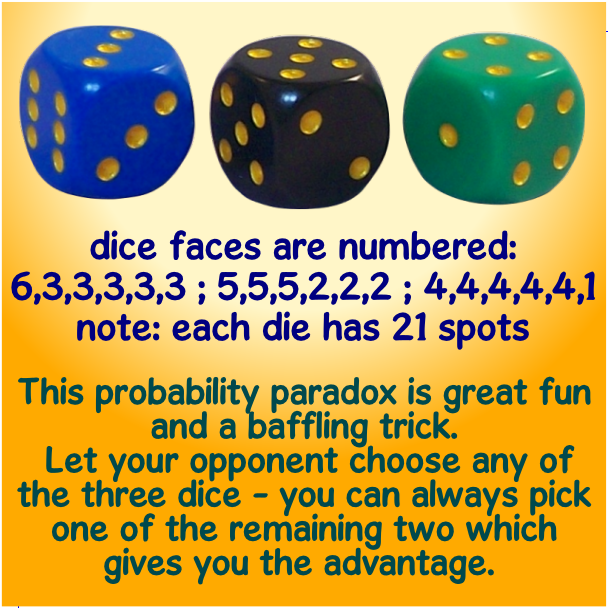A set of non-transitive dice have the peculiar property that no matter which of them is chosen, one of the remaining ones has a statistical advantage over it. You can demonstrate this property with a simple trick :
Ask someone to choose any one of the three dice, then you select one of the remaining two. You both throw your dice at the same time and the highest number wins. If you do this, say ten times, you will almost certainly win more often than your opponent.
You Choose, You Lose! – a set of 3 non-transitive dice .
These dice have the peculiar property that no matter which of the three is chosen, one of the remaining two has a statistical advantage over it. Invite your victim to examine the dice and point out that although the numbering is different, all three dice have the same total number of spots as an ordinary die, ie 21 spots. Ask them to choose any one of the three dice, then you select one of the remaining two. You both throw your dice at the same time and the highest number wins. If you do this, say ten times, you will almost certainly win more often than your opponent.
The reason is that these dice are what mathematicians call “non transitive dice.” They illustrate a probability paradox, or in other words they defy common sense! Imagine a game of scissors-paper-rock where your opponent chooses first. If they choose rock, you choose paper, if they choose paper, you choose scissors. You would always have the advantage. These dice work in a similar way. Despite the fact that they all have the same number of spots, there is a statistical likelihood that each of them will beat one of the remaining ones and be beaten by the other:
4,4,4,4,4,1 will beat 3,3,3,3,3,6 25 times out of 36
3,3,3,3,3,6 will beat 2,2,2,5,5,5 21 times out of 36
2,2,2,5,5,5 will beat 4,4,4,4,4,1 21 times out of 36
The more times you throw the dice, the more likely it is that your total number of wins will be more than that of your opponent.
Swindle your friends and family with the power of mathematics !!
These dice are 16mm (5/8inch), rounded corners, colours : blue, black green.
You may also like …. other Nontransitive Dice options available further down this page:
Nontransitive Dice (set of 4)
Nontransitive Dice – Double Whammy
Size : 16mm (5/8inch)
Shape : rounded edges and corners
Colour : white with black spots.
Materials : injection-moulded plastic.
Other features : The blank dice are made in England from injection-moulded plastic. I use a precision jig system to machine the pip indents into exact position then colour them with a mica infused acrylic paint which is extremely hard-wearing.











